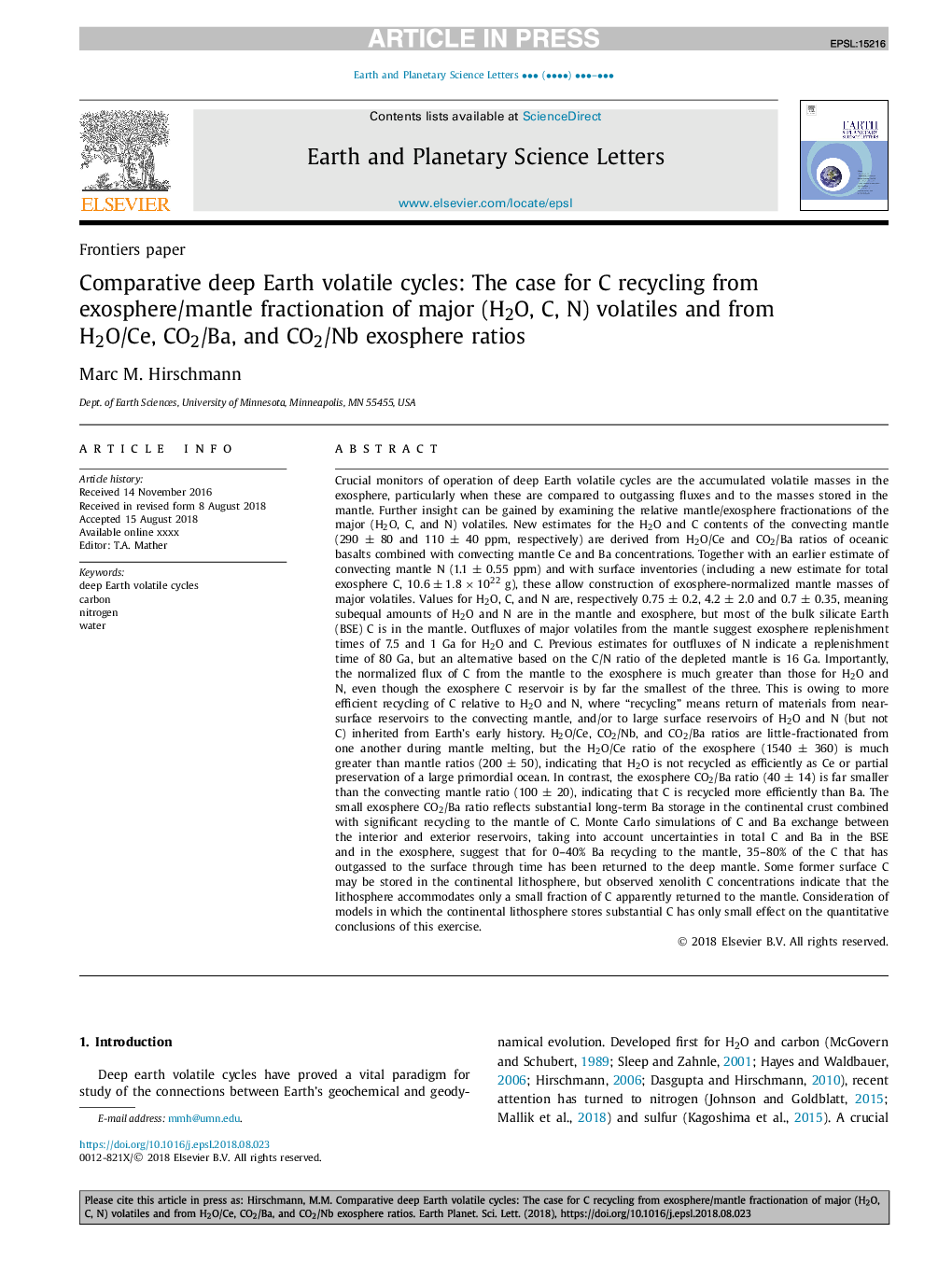| کد مقاله | کد نشریه | سال انتشار | مقاله انگلیسی | نسخه تمام متن |
|---|---|---|---|---|
| 11028518 | 1646778 | 2018 | 12 صفحه PDF | دانلود رایگان |
عنوان انگلیسی مقاله ISI
Comparative deep Earth volatile cycles: The case for C recycling from exosphere/mantle fractionation of major (H2O, C, N) volatiles and from H2O/Ce, CO2/Ba, and CO2/Nb exosphere ratios
دانلود مقاله + سفارش ترجمه
دانلود مقاله ISI انگلیسی
رایگان برای ایرانیان
کلمات کلیدی
موضوعات مرتبط
مهندسی و علوم پایه
علوم زمین و سیارات
علوم زمین و سیاره ای (عمومی)
پیش نمایش صفحه اول مقاله

چکیده انگلیسی
Crucial monitors of operation of deep Earth volatile cycles are the accumulated volatile masses in the exosphere, particularly when these are compared to outgassing fluxes and to the masses stored in the mantle. Further insight can be gained by examining the relative mantle/exosphere fractionations of the major (H2O, C, and N) volatiles. New estimates for the H2O and C contents of the convecting mantle (290 ± 80 and 110 ± 40 ppm, respectively) are derived from H2O/Ce and CO2/Ba ratios of oceanic basalts combined with convecting mantle Ce and Ba concentrations. Together with an earlier estimate of convecting mantle N (1.1 ± 0.55 ppm) and with surface inventories (including a new estimate for total exosphere C, 10.6±1.8Ã1022 g), these allow construction of exosphere-normalized mantle masses of major volatiles. Values for H2O, C, and N are, respectively 0.75 ± 0.2, 4.2 ± 2.0 and 0.7 ± 0.35, meaning subequal amounts of H2O and N are in the mantle and exosphere, but most of the bulk silicate Earth (BSE) C is in the mantle. Outfluxes of major volatiles from the mantle suggest exosphere replenishment times of 7.5 and 1 Ga for H2O and C. Previous estimates for outfluxes of N indicate a replenishment time of 80 Ga, but an alternative based on the C/N ratio of the depleted mantle is 16 Ga. Importantly, the normalized flux of C from the mantle to the exosphere is much greater than those for H2O and N, even though the exosphere C reservoir is by far the smallest of the three. This is owing to more efficient recycling of C relative to H2O and N, where “recycling” means return of materials from near-surface reservoirs to the convecting mantle, and/or to large surface reservoirs of H2O and N (but not C) inherited from Earth's early history. H2O/Ce, CO2/Nb, and CO2/Ba ratios are little-fractionated from one another during mantle melting, but the H2O/Ce ratio of the exosphere (1540 ± 360) is much greater than mantle ratios (200 ± 50), indicating that H2O is not recycled as efficiently as Ce or partial preservation of a large primordial ocean. In contrast, the exosphere CO2/Ba ratio (40 ± 14) is far smaller than the convecting mantle ratio (100 ± 20), indicating that C is recycled more efficiently than Ba. The small exosphere CO2/Ba ratio reflects substantial long-term Ba storage in the continental crust combined with significant recycling to the mantle of C. Monte Carlo simulations of C and Ba exchange between the interior and exterior reservoirs, taking into account uncertainties in total C and Ba in the BSE and in the exosphere, suggest that for 0-40% Ba recycling to the mantle, 35-80% of the C that has outgassed to the surface through time has been returned to the deep mantle. Some former surface C may be stored in the continental lithosphere, but observed xenolith C concentrations indicate that the lithosphere accommodates only a small fraction of C apparently returned to the mantle. Consideration of models in which the continental lithosphere stores substantial C has only small effect on the quantitative conclusions of this exercise.
ناشر
Database: Elsevier - ScienceDirect (ساینس دایرکت)
Journal: Earth and Planetary Science Letters - Volume 502, 15 November 2018, Pages 262-273
Journal: Earth and Planetary Science Letters - Volume 502, 15 November 2018, Pages 262-273
نویسندگان
Marc M. Hirschmann,